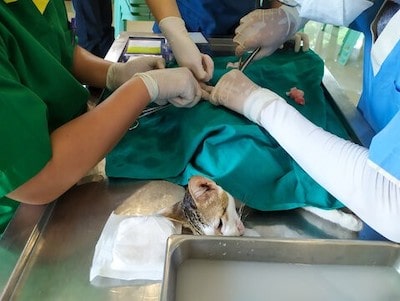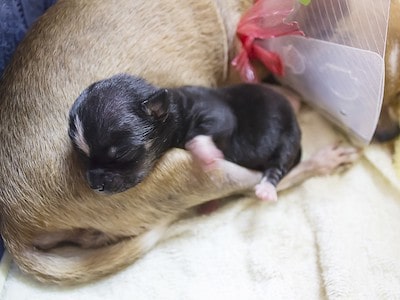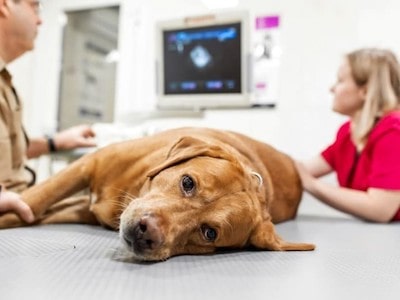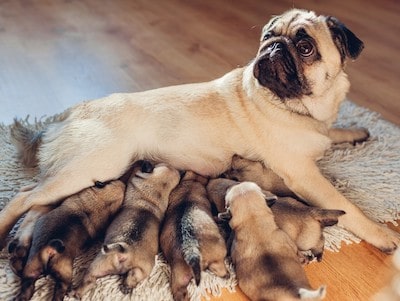Bringing new life into the world is an exhilarating experience, especially when it involves our beloved furry friends. However, sometimes circumstances arise where a dog requires a C-section surgery to safely deliver her puppies. This surgical procedure, while essential, can be challenging for both the mother dog and her human caretakers.
After the surgery, it’s crucial to provide the right care and support to ensure the well-being of the mother and her newborns. In this article, we will delve into the post-operative care needed for a dog and her puppies following a C-section surgery.
We’ll explore important considerations, tips, and best practices to help you navigate this critical period and promote a healthy recovery for the mother dog while ensuring the proper development of her precious puppies.
So, let’s dive in and discover the essential steps to caring for your dog and her puppies after a C-section surgery.
What is a Dog C-Section Surgery?
A dog c-section surgery is a surgical operation that involves making an incision in the abdomen and the uterus of the mother dog and carefully removing the puppies one by one. The puppies are then checked for vital signs, cleaned, dried, and stimulated to breathe.
The mother’s uterus and abdomen are then sutured closed and she is given pain medication and antibiotics. The mother and the puppies are then monitored closely for any signs of complications or infection.
A dog c-section surgery can be either elective or emergency. An elective c-section is scheduled in advance for dogs that have had previous dystocia or c-sections, or for dogs that are expected to have difficulty with natural birth due to factors such as:
- Large or oversized puppies
- Small or narrow pelvic canal
- Pelvic fracture or malunion
- Uterine inertia or poor contractions
- Brachycephalic breeds (such as Bulldogs, Pugs, Boston Terriers, etc.)
- Multiple pregnancies

An emergency c-section is performed when there is an urgent need to deliver the puppies due to life-threatening complications such as:
- Prolonged labor (more than four hours between puppies)
- Fetal distress (abnormal heart rate, weak movements, etc.)
- Uterine rupture or torsion
- Placental detachment or bleeding
- Maternal distress (fever, shock, toxemia, etc.)
A dog c-section surgery can save the lives of both the mother and the puppies in these situations. However, it also carries some risks and challenges, such as:
- Anesthesia complications (such as low blood pressure, hypothermia, respiratory depression, etc.)
- Hemorrhage or infection
- Uterine adhesions or scarring
- Reduced milk production or maternal bonding
- Stillbirth or neonatal death
Therefore, a dog c-section surgery should only be performed by a qualified veterinarian with experience in this procedure. The veterinarian will assess the condition of the mother and the puppies and decide whether a c-section is necessary and feasible.
Factors That Affect the Cost of a Dog C Section Surgery
The cost of a dog C section surgery can vary widely depending on several factors, such as:
- Breed: Some breeds are more expensive to operate on than others, due to their anatomy, size, or popularity. For example, brachycephalic breeds may require more specialized equipment and care than other breeds.
- Location: The cost of living and veterinary fees in your area may affect the price of the surgery. Generally, urban areas are more expensive than rural areas.

- Complications: If your dog has any pre-existing health conditions or develops any complications during or after the surgery, such as bleeding, infection, or milk fever, she may require more tests, medications, or hospitalization, which will increase the cost.
- Emergency vs. planned: An emergency C section is usually more expensive than a planned one, because it requires more staff, resources, and urgency. An emergency C section may also have lower success rates than a planned one.
The average cost of a dog C section surgery in the US ranges from $500 to $2,000, but it can go up to $4,000 or more in some cases. It is advisable to consult with your veterinarian beforehand and get an estimate of the cost based on your dog’s specific situation.
How to Prepare Your Dog for a C Section Surgery
If your dog is scheduled for a C section surgery, there are some steps you can take to prepare her for the procedure and ensure a smooth recovery:
- Pre-surgery tests: Your veterinarian may perform some tests on your dog before the surgery, such as blood work, X-rays, ultrasound, or progesterone levels. These tests will help determine the best time for the surgery and rule out any potential problems.
- Fasting: Your dog will need to fast for 8 to 12 hours before the surgery, depending on your veterinarian’s instructions. This will prevent vomiting and aspiration during anesthesia.

- Anesthesia: Your veterinarian will choose an appropriate anesthetic protocol for your dog based on her age, health status, breed, and pregnancy stage. Most dogs are given a combination of sedatives, painkillers, and inhalant anesthetics to induce and maintain anesthesia. The anesthetic drugs will cross the placenta and affect the puppies, so it is important to minimize the time from induction to delivery.
- Shaving and scrubbing: Your dog’s abdomen will be shaved and scrubbed before the surgery to reduce the risk of infection. You may want to do this at home before bringing your dog to the clinic, or have it done by the veterinary staff.
What to Expect During and after a C Section Surgery
The veterinary staff will keep a close eye on your dog’s vital signs throughout the procedure, including heart rate, blood pressure, oxygen saturation, and temperature. In order to reduce the stress on the mother and the puppies, the procedure will be carried out as fast and securely as possible.
The puppies will be brought in one at a time, and each one will be examined for health, sex, weight, and any anomalies. When the mother is prepared to nurse, they will either be placed in a heated incubator or covered in towels.
Your dog will receive medications and antibiotics after the procedure to help avoid infection. In order to help her recuperate from the blood loss and dehydration, she will also be given fluids and nutrients.
After the procedure, she could be sleepy or confused for a few hours, but she should quickly regain her appetite and interest in her babies. After the procedure, it’s usual for her to experience a few days of bloody vaginal discharge.
Depending on her condition and the clinic’s policies, your dog will need to remain in the facility for observation for 12 to 24 hours following the procedure. During this period, you might be permitted to see her and her puppies, but you should heed the doctor’s advice and avoid causing them undue stress.
After your dog is released from the hospital, you must take her home where you may provide her a cosy, peaceful, and clean environment to relax and feed her babies.
How to Care for Your Dog and Her Puppies after a C Section Surgery
Caring for your dog and her puppies after a C section surgery can be challenging but rewarding. Here are some tips to help you:
- Check the incision site: You should check your dog’s incision site daily for any signs of infection, such as redness, swelling, discharge, or odor. You should also prevent your dog from licking or biting the stitches, which may require an Elizabethan collar or a bandage. The stitches will usually be removed 10 to 14 days after the surgery.
- Feed your dog well: Your dog will need more food and water than usual to produce enough milk for her puppies and heal from the surgery. You should feed her a high-quality dog food that is formulated for gestation and lactation, such as those that have passed AAFCO feeding trials. You should offer her small amounts of food and water frequently throughout the day, especially in the first 24 hours after surgery. You should avoid giving her any supplements or medications without consulting your veterinarian.
- Monitor your dog’s temperature: Your dog’s temperature may rise slightly in the first one to three days after delivery, but it should return to normal within a week. The normal range is 100-102°F (37.8-38.9°C). If your dog’s temperature goes above 104°F (40°C), she may have an infection or inflammation and should be seen by your veterinarian as soon as possible.

Watch for signs of complications: Some of the possible complications that can occur after a C section surgery are:
1) Mastitis: This is an infection of the mammary glands that causes pain, swelling, redness, and discharge in the nipples. It can affect one or more glands and can make nursing difficult or impossible. Mastitis can be treated with antibiotics and warm compresses.
2) Metritis: This is an infection of the uterus that causes fever, lethargy, loss of appetite, foul-smelling vaginal discharge, and abdominal pain. Metritis can be life-threatening if not treated promptly with antibiotics and fluids.
3)Eclampsia: This is a condition caused by low blood calcium levels that occurs in nursing mothers. It causes muscle tremors, seizures, weakness, panting, drooling, and collapse. Eclampsia can be fatal if not treated immediately with calcium injections.
4) Postpartum hemorrhage: This is excessive bleeding from the uterus that occurs within 24 hours after delivery. It can cause shock, pale gums, weakness, rapid breathing, and collapse. Postpartum hemorrhage can be caused by uterine rupture, retained placenta, or coagulation disorders.
FAQs
Recovery time can vary depending on the dog’s health, age, and the complexity of the surgery. Generally, it takes around 10 to 14 days for the incision to heal, but complete recovery may take several weeks.
rovide a calm and stress-free environment for the mother dog. Ensure she has access to fresh water, nutritious food, and a comfortable resting area. Administer prescribed medications, monitor the incision site for any signs of infection, and limit physical activity as advised by the veterinarian.
As with any surgical procedure, there are risks involved, such as infection, excessive bleeding, or reactions to anesthesia. Proper pre- and post-operative care, along with close monitoring, helps mitigate these risks.
In some cases, a dog that has undergone a C-section may be able to have a natural birth in subsequent pregnancies. However, it is crucial to consult with your veterinarian to assess the specific circumstances and potential risks.
Final Words
Caring for a dog and her puppies after a C-section surgery is a crucial responsibility that requires attention, patience, and knowledge. By providing the right post-operative care, you can help the mother dog recover and ensure the healthy development of her precious puppies.
From creating a calm and comfortable environment to monitoring their well-being and seeking professional guidance when needed, every step contributes to their overall health and happiness.
Remember to follow your veterinarian’s instructions closely, including administering medications, monitoring the incision site, and scheduling follow-up visits. Patience is key during this recovery period, as it may take time for the mother dog to regain her strength and for the puppies to grow and thrive.
By understanding the unique needs of a dog and her puppies after a C-section surgery, you can offer the support and care necessary for their well-being. Embrace the journey and enjoy witnessing the miraculous bond between the mother and her adorable offspring.
As responsible pet owners, let us prioritize the health and welfare of our furry companions. By staying informed, seeking professional guidance, and providing the necessary care, we can ensure a positive outcome for both the mother dog and her adorable puppies. Cherish this extraordinary experience and create lasting memories as you embark on this beautiful journey of nurturing and love.

Ellis is a retired veterinary technician and full-time contributor at DogLovesBest. He likes writing about pet health care tips and reviews the products that are useful for fidos on a daily basis.
Ellis also guardians a Siberian husky, Nova, and a cat named Shilly. They all live happily with his wife Ammy, and both the dogs on a seaside apartment in Queens, NY.
